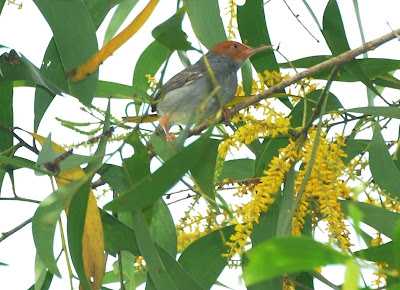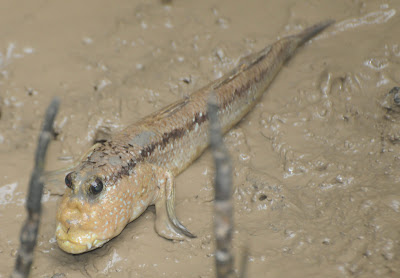Ryan has become a real wetland enthusiast, and a wetland with mudskippers is his idea of heaven. The mangrove boardwalk at the Malaysian Nature Society's Kuala Selangor Nature Park, on the west coast of the Peninsula, therefore became a "must" last stop on our 2011 spin through New Zealand and Peninsular Malaysia.
We had only a few days before Eileen and I had to take Ryan back to his parents in Kuching (in time for his New Year's Eve birthday), but our friends Chips and Shirley arranged things for us. On December 28 Ryan and I headed down from Kuala Lumpur to the coast with Chips, Shirley, Terry Law and young Cheok Chun Chong, home on vacation from his high school in Beijing and eager to record the day on video for a film-making project. Ryan immediately adopted him as a temporary big brother.
As we headed through the coastal forest to the boardwalk, we were greeted by a primate reception committee. Kuala Selangor is home to two very different monkeys. Long-tailed Macaques (Macaca fascicularis) are aggressive omnivores (and inveterate garbage-raiders), in trees or on the ground. Many people heartily dislike them - probably because they behave uncomfortably like our own pugnacious and opportunistic species, and we can't have that.
An altogether different animal is the Silvered Langur or Leaf-Monkey (Trachypithecus cristatus). It is a committed vegetarian, living largely on leaves though it will also eat fruit, seeds, flowers and other plant parts. It has a specially modified stomach to help it handle the load of cellulose in its diet. Unlike the macaque it spends comparatively little time on the ground (and you are less likely to be bitten by one).
One of the most attractive trees of the mangrove forest is Mangrove Apple or Perapat (Sonneratia alba). It can tolerate high levels of salt in the soil - pretty much a requirement for any plant that wants to survive here. Like the black mangroves (Avicennia) it sends up aerial roots - pneumatophores - that project above the soil like miniature obelisks and allow the plant to take up oxygen from the air. According to a helpful sign on the path, its flowers open at dusk, smell of soured milk, last only one night and are pollinated by fruit bats.
… or a strikingly-plumed caterpillar making short work of a mangrove leaf.
Butterflies along the way included a Blue Glassy Tiger (Ideopsis vulgaris macrina)...
…and its considerably rarer cousin, the Malay or Mangrove Tiger (Danaus affinis malayanus), a specialty of the area. Mangrove Tigers are found in numbers only at two sites in Malaysia, one of which is Kuala Selangor. For North Americans, the tigers are cousins of the familiar Monarch (Danaus plexippus), and like the monarch they lay their eggs on various species of milkweed. The Mangrove Tiger (which looks rather like a rather gaudy Monarch) is but one of about 30 subspecies of D. affinis ranging from Thailand to Australia, some much more black-and-white than this one.
There were, of course, birds, too, but we had arrived a bit too late in the morning for their main rush of activity. Ashy Tailorbirds (Orthotomus ruficeps), though, keep active pretty much throughout the day.
A wooden observation tower near the head of the boardwalk gave a good view both of the surrounding country and of any birds sitting in the treetops.There were, of course, birds, too, but we had arrived a bit too late in the morning for their main rush of activity. Ashy Tailorbirds (Orthotomus ruficeps), though, keep active pretty much throughout the day.
Here is a Brahminy Kite (Haliastur indus), the commonest raptor of the mangroves.
In the distance we spotted two Lesser Adjutants (Leptotilos javanicus), huge, rather forbidding-looking storks with nearly bare heads and necks and massive bills. It is a species in decline: there are probably only about 500 birds in the whole of Malaysia.
The Dollarbird (Eurystomus orientalis) is a handsome creature, but it's not always easy to get eye-level with one.
Back at ground level, we set out along the boardwalk, our eyes peeled for mudskippers. This bright little fungus was sprouting directly from the boardwalk's timbers.
No mangrove flat in the world is complete without fiddler crabs (Uca spp.), the males attempting to wave over potential mates (or wave away rivals) with their oversized right claws. There are 101 recognised species worldwide - for information and photographs of many of them see here.
Far less obvious are these mangrove crabs (genus Perisesarma, I think - a genus whose members, according to Wikipedia, "eat nearly anything they can and will try to eat anything that doesn't threaten them — including pencils and other objects dropped on the forest floor").
Even less obvious are tiny hermit crabs huddled beneath their snail-shell homes. The shells former owner may be the Truncated Mangrove Snail or balitong (Cerithidea decollata), a local delicacy. The snails retreat to the mangrove trunks when the tide comes in and return to the mud once the waters ebb, a migratory behaviour that has been studied in East Africa.
This shell carries its crustaceans on the outside. Rock barnacles need somewhere solid to attach themselves, and there aren't a lot of rocks out here.
Long-tailed Macaques are also called Crab-eating Macaques, and the remains of these horseshoe crabs may be evidence of their handiwork. Of course horseshoe crabs aren't really crabs or even crustaceans, but let's not be picky.
Three of the world's four horseshoe crab species occur in Malaysia (the other one, Limulus polyphemus, lives on the eastern seaboard of North America). For a detailed article on horseshoe crabs in Malaysia see here. Based on the large size of the spines bordering the opisthoma, or abdomen, and the smooth leading edge of the prosoma (the big piece at the front) these are Coastal Horseshoe Crabs (Tachypleus gigas).
One of the mangrove flat's genuine crustaceans rarely shows itself. It reveals its presence, however, with these strange objects, rather like miniature mud volcanoes (some of them aren't so miniature - they can be three metres tall!). They are the work of the Mud Lobster (Thalassina anomala), an important (if rarely seen) inhabitant of the mangrove ecosystem whose burrows aerate the soil, recycle organic debris and facilitate the growth of a number of tree species. Also, they spur visitors to ask useful questions, like "What the heck is that?"
These are Giant Mudskippers (Periophthalmodon schlosseri), a species we missed on our last mangrove walk in Singapore. That broad black stripe along the side is a give-away (though not every individual is as strongly marked as this one).
As their name suggests, they are one of the largest mudskippers in the world, reaching an impressive 27 cm. They are active hunters, feeding mostly on crabs but even preying on smaller mudskippers - which may explain why we didn't see any other species around!
I think mudskippers appeal to kids (Ryan included) because they look so much like frogs gone wrong. It's the googly eyes, of course. Anyway, that's why they appeal to me - though the zoologist in me can't help but look at these highly-derived, modern fishes (there are no known fossils, apparently) as they peer above the surface or hop about on the flats without harking back a few hundred million years to the utterly different fishes, on a lineage quite different from the one that has led to the mudskippers, whose lineal descendants we are. When I delight in mudskippers, am I responding to a sympathy between one fish out of water and another?






























No comments:
Post a Comment